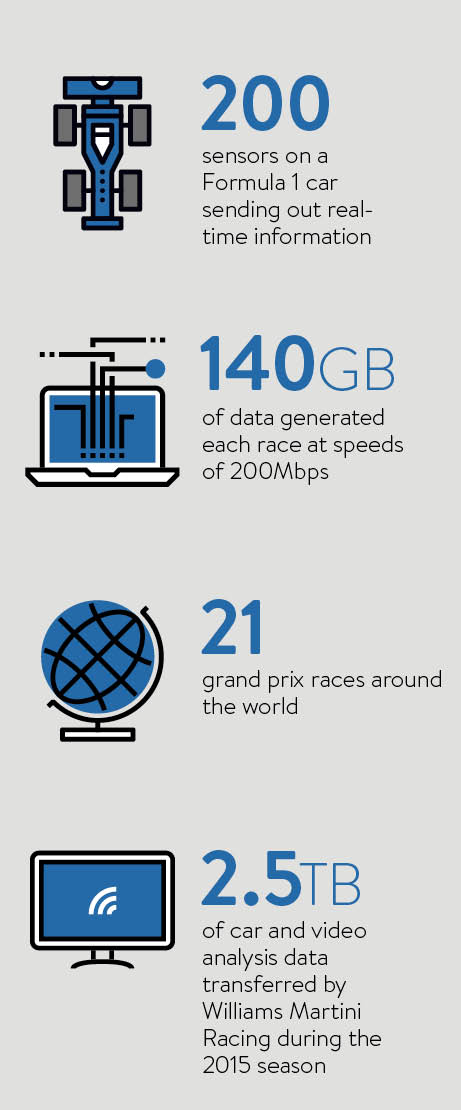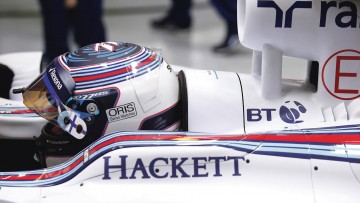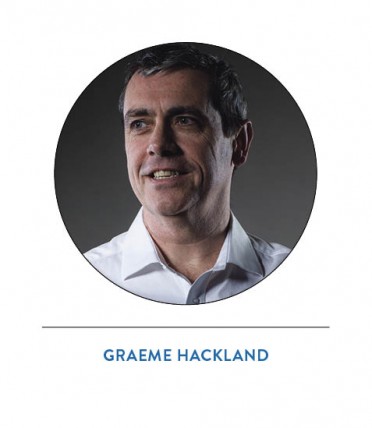When BT joined forces with Williams Martini Racing a year ago, it was clear from the start that they were a perfect match – two classic British brands which combine speed and technology in their quest for success.
Despite the obvious synergies, it was BT’s first foray into Formula 1 and is the start of an exciting collaboration between the two companies. This is not simply a sponsorship deal, but a true partnership designed to return Williams to the top of the podium.
“Our partners are our lifeblood,” says deputy team principal Claire Williams. “Without them, we don’t go racing.” And in a short time BT has made itself an integral part of the line-up.
The partnership comes at a crucial stage in the team’s history. With 16 world championships and 114 grand prix victories, Williams is F1’s third most successful team. However, by its own admission, 2013 was its worst year ever on track, scoring a mere five points and managing no race finish higher than eighth. For a team that had dominated F1 in the 1980s and 1990s, it was a wake-up call.
Williams resolved to change everything around. In the wake of that season, a new leadership team came together and put in motion a series of plans to make some big changes at the team, resulting in structural improvements, a new engine partner, Mercedes, and new personnel, including new drivers Felipe Massa and Valtteri Bottas.
A proactive strategy to connect with strong new partners was also instituted with a focus on brands that would support the team’s technical and digital transformation.
It was this programme that brought BT in to collaborate around how technology could support the team’s ambitions. “BT has played a really important part in our transformation,” says Ms Williams. “When we started this in 2013, the big part we were missing was the digital part. We discovered that in an industry which is so fast moving and so reliant on data, we had allowed our IT capabilities to fall behind.
 “The technologies and services that they have provided to us have already had a major impact on our performance and we can see this on the race track.”
“The technologies and services that they have provided to us have already had a major impact on our performance and we can see this on the race track.”
In the world’s most technologically advanced sport, data is king. BT enables members of the Williams Martini Racing team to communicate and collaborate with any team member wherever they are in the world – at the race track, in the race operations room or even working remotely – which is key, given current Formula One Management rules that restrict the number of engineers allowed to be trackside during a race.
BT’s end-to-end global IP infrastructure facilitates secure high-speed communication between team members at the track with engineers as far as 10,000 miles away in the team’s factory in Grove, Oxfordshire. Thanks to BT, huge quantities of data can be shared and analysed in real time from race tracks in locations ranging from Melbourne to Montreal and São Paulo to Singapore.
It’s a highly competitive environment. Each F1 car is fitted with around 200 sensors which send out real-time information. These sensors measure everything from engine performance to fuel levels to oil temperature and tyre pressure. Teams predict their finishing positions long before the lights go out and the team often knows that a car is about to suffer a problem several laps before anything becomes visible to TV viewers.
“I don’t believe you can ever have too much data,” says Ms Williams. “Data is what helps us win. The data that we receive from the car, and how our people interpret that data and develop the car, is what separates us from the competition.”
Williams is now enjoying its best run of performance since the early-2000s and with 13 podium places in the last two seasons, it is looking to continue pushing forward. Speed is everything in F1, both on and off the track. Data must be analysed quickly to give the driver an opportunity to react to it, and information that shaves just a few thousandths of a second off a lap time can make the difference between winning and losing a race.
BT’s network plays a crucial part in this, allowing the team to run up to 1,000 race simulations per minute. It also enables quicker remote access to information, and improves the performance and reliability of demanding computing processes, including applications which rely on video, telemetry and voice. As a result, the team can now interrogate its remote systems and export the required information to the race track in a matter of minutes, allowing for real-time decision-making.
This is a partnership that allows us to showcase and test our technology in the most demanding of conditions
The new network infrastructure has been further optimised through the deployment of WAN acceleration capabilities, removing latency issues and helping the teams prioritise certain data so that the most important data is always processed first. The infrastructure is also intelligent, self-healing, and enables streaming of high volumes of data across multiple datacentres and numerous device types. This is important for Williams Martini Racing’s IT team which needs the right infrastructure to transport, store, secure and analyse the enormous volumes of data generated at each race.
After the race, updates are made to the car based on analysis of the data, which means the car on the grid at the end of the season can be substantially better than the one that lined up at the first race. As each team makes improvements, its rivals are also changing their own car, so the ability to analyse data quickly and accurately is critical.
Gavin Patterson, chief executive of BT Group, says: “This is a partnership that allows us to showcase and test our technology in the most demanding of conditions. It is a great way to demonstrate to our customers what technology can bring to their business, but we are also learning more about what we are capable of ourselves.”
Across the 2015 race season, 2.5 terabytes of car and video analysis data was transferred by the Williams Martini Racing team, equivalent to more than 4,300 HD television programmes. BT’s network securely carries up to 140GB of this data per race at speeds of 100Mbps. BT’s faster network connection makes a tangible difference during the race weekend and developments such as real-time video analysis of pit stop practice have enabled quicker decisions that can improve car performance.
Prior to Williams joining forces with BT, video analysis of pit stop and practice performance had to be conducted overnight. Computation of some performance data has improved by 200 times.
Constant improvement is necessary in F1 to stay ahead of the competition. “Technology in the past ten years in Formula 1 has really moved along, and now it’s all about the new technologies that a team can develop and bring to the race,” says Ms Williams. BT is playing a crucial part in that.
In Grove, BT provides a campus LAN to ensure a stable high-capacity service across the entire Williams operation, from the analysts working in the heart of the race support room to non-racing services, such as the team’s conference centre and sister company, Williams Advanced Engineering, which is located on the same site.
The capability to carry big data is particularly important for operations of the team’s wind tunnel which, according to Formula One Management rules, can only be operated a limited number of times per season. This means that every session has to produce the maximum amount of feedback and data about the car’s aerodynamics.
 And it’s not just about high-tech solutions that wouldn’t be found in an ordinary office. BT One Phone was recently installed at Grove to give Williams staff the functionality of their desk phones from a mobile.
And it’s not just about high-tech solutions that wouldn’t be found in an ordinary office. BT One Phone was recently installed at Grove to give Williams staff the functionality of their desk phones from a mobile.
The team’s drivers have also felt the difference. Brazilian Massa, an 11-times race winner and one of the most experienced drivers on the grid, notes that nowadays, when he climbs out of the cockpit, he is immediately presented with all the analytical reports he needs for the team debrief.
“From my perspective, the difference between before and now is that when I come into the garage after a session, everything is already on the screen – the data is there to analyse,” he says. “Also, during a race, the pit team can see any mistakes straight away, like if I brake too early or too late. I can’t hide anything!”
It’s a big change from when he first joined F1 back in 2002, but one which continues to encapsulate the ethos of the sport. “It’s all about speed,” says Massa. “The messages that we give to the team and the messages they send us back need to be the fastest possible. We are not here to participate. We are here to win.”
BT’s technology connects everyone at the team, from Massa and Bottas to the junior mechanics. “Team work is absolutely critical to what we do,” says Ms Williams. “Success comes from a really great group of people who work well together, and can communicate and collaborate effectively.”
One of BT’s most important roles is to provide a platform which enables the passionate team members to perform at their optimum level. “Our role is all about enabling the people at Williams Martini Racing to be the best they can be and to deliver the best performance,” says Mr Patterson. “Technology on its own doesn’t win races. It’s how it gets used that makes things really exciting.”
It’s experience which will enable BT to improve its services to benefit clients in other areas of its business. It works with companies in diverse sectors, including engineering, healthcare and aviation, which all require real-time connectivity to solve critical problems. The experience with Williams will boost what BT can offer clients.
Ms Williams is in no doubt the partnership has already been a success. “I think it’s incredibly exciting to see where our partnership with BT is going to go in the future,” she says. “We have a great platform from which to work, and we’ve already seen that the technologies BT has integrated within the racing environment have driven improved performance. It’s enabled our engineers to work harder, to work smarter, and this is exactly what we need them to be doing if we are to close that gap.”
Q&A WITH GRAEME HACKLAND
Williams Martini Racing IT director

Q: What unique IT challenges does Williams face?
A: The biggest challenge that we have is the constant need to improve, and to innovate, to remain ahead of the competition. The team that works on the car is used to this, of course, and so this is expected across the board from everyone at the company. Race tracks also tend to have very little IT infrastructure in place prior to a race, so we need a flexible partner, such as BT, who we can trust to get the job done to a high standard in a short space of time.
Q: How important is IT to Formula 1?
A: The right IT infrastructure is critical to our success because now we are moving data around the world – data that has been generated by a Formula 1 car going around a track at 300 kilometres per hour. Being able to move the data in real time, over a secure and reliable network, allows our engineers to work on that data and to feedback to improve the performance of the car.
Q: What are your other key IT concerns?
A: With around 650 people working at the company, the majority of them based at our HQ in Grove, we need to support every one of them and all their communications, networking and remote-working requirements. Our campus network needs to be able to withstand high capacity data peaks so that when we are operating our wind tunnel or receiving data from the race track, this doesn’t impact upon our day-to-day computing needs.
Q: What is the one thing that you always keep in mind when making IT decisions?
A: Teams of our size in Formula 1 need to be really clever about where to direct investment and resources, and the thing I always ask myself is “will it make the car go faster”. If it makes the car go faster, then we do it, and if it’s not contributing to that in some way, then we don’t do it – it’s that simple. In fact, for all types of businesses there is the equivalent of “making the car go faster” and technology should be driving that.


Q&A WITH GRAEME HACKLAND

